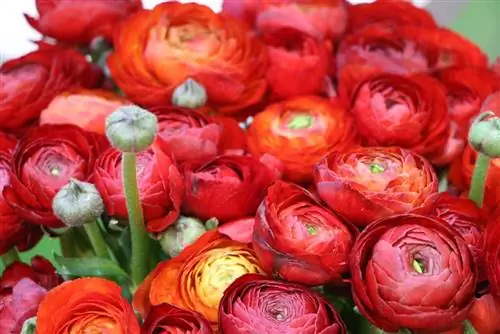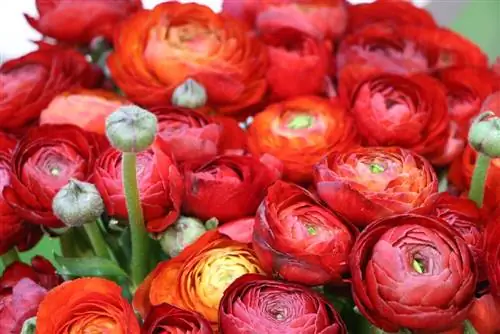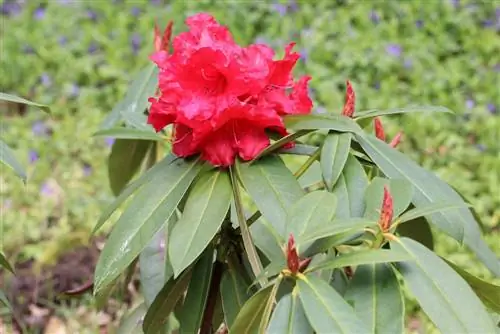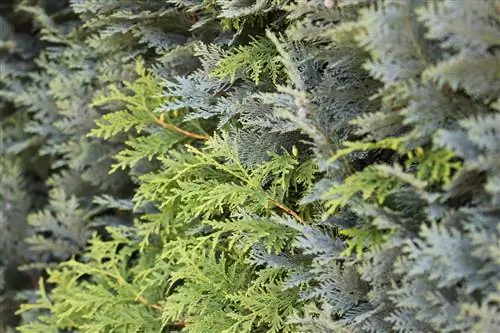- Author admin [email protected].
- Public 2023-12-17 03:39.
- Last modified 2025-06-01 06:48.
The ranunculus was once as popular in Europe as the tulip. Unfortunately, that changed towards the end of the 19th century. People lost some interest in the beautiful summer flower. Other types of flowers were now more popular. For a long time, the ranunculus was almost forgotten. Fortunately, that has long since changed. This fascinating plant has enjoyed increasing popularity again for many years. The reasons for this renaissance are obvious: Ranunculus impress with its fascinating flowers and are also easy to care for.
Origin, growth and flowering
The original home of Ranunculus asiaticus, the ranunculus' Latin name, is the Orient. The fascinating plant came to Western Europe from Turkey in the 16th century. It is a typical tuberous plant and botanically belongs to the buttercup family. This also means that the ranunculus is poisonous. The protoanemonin it contains makes it completely inedible for humans and animals. They are considered so-called early summer bloomers that display their full color splendor between May and July. Depending on the variety, ranunculus grow to a height of between 20 and 40 centimeters and a width of around 20 centimeters. They bloom in a wide variety of colors. The color spectrum, which is constantly being used by new breeds, now knows hardly any limits. The most common colors are yellow, orange, pink, red and white.
Location and soil
Ranunculus like the sun, but not direct sunlight. This applies in summer especially to the brutal midday sun, which is definitely not good for the plants. A sunny or partially shaded location is ideal.
Tip:
Sun protection or shade can be created by combining them with so-called companion plants such as goose cress.
The location should also be reasonably protected. The ranunculus cannot tolerate whipping winds or heavy downpours. The topic of water in general: The ranunculus likes it moist, but cannot tolerate moisture. Waterlogging in particular must therefore be avoided at all costs. It would quickly kill the plant. If the soil in the garden is clayey, drainage should also be created underground. This is also recommended if ranunculus are cultivated in plant pots. A humus-rich substrate mixed with sand or some gravel has proven to be a suitable soil.
Sowing or planting
Ranunculus is available in specialist stores either as seeds or as flower bulbs. Which method you choose is ultimately a question of personal taste. In any case, sowing works just as well as planting. The seeds are generally sown in autumn - and not directly outdoors. Rather, it is necessary to grow them in a flower pot in order to protect the young plants from the winter cold. You proceed as follows:
- Press seeds lightly into a nutrient-rich substrate
- Water well immediately, but definitely avoid a build-up of moisture
- Place the planter in a warm and bright location
- possibly cover with a transparent plastic film to achieve a greenhouse effect
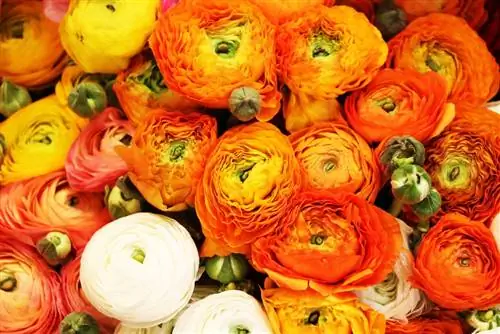
After germination, the plants form small, elongated tubers that remain in the container until they are planted outdoors. If you want the ranunculus to continue growing in a plant pot, it should definitely be repotted in spring. However, if it is planted directly in the garden, it is crucial that the weather conditions are right. Ground frosts are an early death for ranunculus. March and April have proven to be the ideal spring planting time. The best way to plant is as follows:
- first place the tubers in a water bath for three to four hours
- water the soil well for the tubers
- Place the tubers themselves about five centimeters deep in the ground and cover them with soil
- then water well again, but avoid waterlogging
- keep the soil moist at all times afterwards
Care
As already mentioned, ranunculus are extremely easy to care for. If the location and soil conditions are right, you actually hardly have to work with the plants. The only important thing is that the soil is kept permanently moist. If the ranunculus are outdoors and it is not raining, they must be watered. This applies to both varieties planted directly in the garden and those native to plant pots. Of course, it also means that the moisture in the soil must be checked regularly. Excessive moisture can cause the leaves of the plant to turn yellow or even the tubers to rot.
Too little water quickly leads to the plant drying out or not blooming at all. It is essential to fertilize during the flowering period from April to July. In this phase, the plants need a lot of nutrients, which are usually no longer contained in the soil. Fertilization can be done in two different ways:
- through the direct administration of compost
- using commercially available flower fertilizer in irrigation water
Regular fertilization is essential, especially for varieties that have very large or sprawling flowers, otherwise the ranunculus would literally starve.
Cut
The usual plant pruning is actually not necessary for ranunculus. The above-ground, i.e. visible parts of the plants die off in autumn or winter anyway, which is why growth cannot be influenced by pruning. However, by making certain cuts you can sometimes significantly extend the flowering time. Please note the following:
- Be sure to cut off flowers that begin to wilt to encourage the plant to form new buds
- Remove dead leaves immediately to ensure better growth and protect against fungal attack
- If ranunculus are very close together, use a thinning cut to create more space
The cut should be done with well-functioning secateurs or a sharp knife. It is always important to work as carefully as possible to avoid major injuries to the plant.
Diseases and pests

Ranunculus have two main enemies - mildew and snails. If powdery mildew occurs on a plant, it should be removed immediately to prevent the infestation from spreading to other plants. You may be able to try treating an infected plant with fungicides. Snails, on the other hand, can be kept away from the ranunculus relatively easily with a snail fence or slug pellets.
Tip:
If the ranunculus is infested with aphids, the best way to combat this is with nettle broth.
Propagation
If you don't want to buy seeds or tubers regularly, you can take advantage of a special property of ranunculus. During the year it produces so-called mother tubers, namely small breeding tubers. These can then be replanted directly as offshoots next spring. Alternatively, large tubers can easily be divided in late autumn and then replanted separately in spring. In the best case scenario, you can double the number of plants. And finally there is the possibility of obtaining seeds from the flowers. To do this, however, they must be faded and well-ripened.
Wintering
Ranunculus are not hardy plants. They therefore need special protection during the winter months. There are basically two options for this. Either you leave the tubers in the ground, but cover them very well with compost, brushwood and pine greens, or you dig them up and then store them dry and frost-free at temperatures of six to eight degrees Celsius. The latter should definitely be used for all ranunculus that grow in a planter. The tubers can then easily be planted again next spring.

